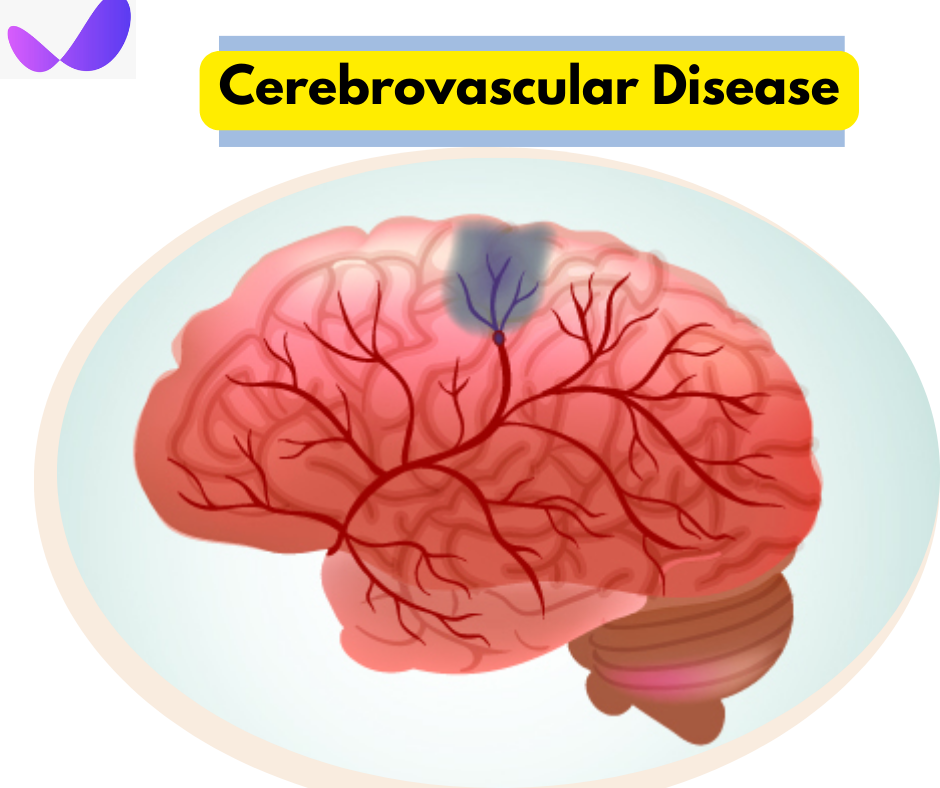A disorder that affects the blood vessels supplying the brain is known as cerebrovascular disease, or CVD for short. In this post we will know about cerebrovascular disease, its type, risk factors, symptoms, diagnosis, treatments, lifestyle modifications for management, and preventive measures for long-term improvement.
What is Cerebrovascular Disease?
Cerebrovascular disease made by combination of two words “Cerebro+ Vascular” where Cerebro refers to mind and Vascular refers to blood vessels ( arteries and veins). A collection of diseases known as cerebrovascular disease impact the blood arteries that supply the brain. These ailments consist of vascular dementia, transient ischemic attack (TIA), and stroke. They frequently stem from issues with blood supply to the brain, which can cause a variety of neurological symptoms.
Types of Cerebrovascular Diseases
The three most prevalent forms of cerebrovascular diseases are transient ischemic attack (TIA), hemorrhagic stroke, and ischemic stroke. In contrast to hemorrhagic stroke, which involves bleeding into the brain tissue. Ischemic stroke happens when a blood clot plugs a blood vessel in the brain. A transient obstruction of the blood supply to the brain, known as a TIA or "mini-stroke,". Some other types are ;
- Cervical artery dissection.
- Reversible cerebral vasoconstriction syndrome.
- Subarachnoid hemorrhage (SAH).
- Hereditary hemorrhagic telangiectasia (HHT).
- Moyamoya disease.
- Arteriovenous malformation (AVM).
- Brain aneurysm.
- Brain bleed, hemorrhage
Risk Factors Associated
There are multiple risk factors that raise the chance of having cerebrovascular disease. These include;
- Obesity,
- Smoking,
- Diabetes,
- High Blood Pressure,
- High Cholesterol,
- Sedentary Lifestyle.
Symptoms and Diagnosis of Cerebrovascular Disease
Symptoms
Symptoms of cerebrovascular disease vary depending on the type and area of the brain affected. Common symptoms include;
- Vision Loss Or, visual field cut or double vision.
- Paralysis or weakness on one side of the body/face.
- Sudden, severe headache.
- Trouble speaking or understanding speech (aphasia).
- Slurred speech (dysarthria).
- Sensory changes in one side of the body/ face.
- Balance problems.
- Delirium.
- Fainting.
Diagnostic Procedures and Tests
Cerebrovascular disease needs a quick diagnosis. Doctors firstly check the family history. Then they will do the following test;
- Mental status .
- Eye movements or vision changes as above.
- Weakness or paralysis.
- Reduced or abnormal sensations.
- Different aspects of speech like fluency, comprehension and naming.
- Loss of balance and coordination.
- Vertigo or room spinning sensation.
If doctors suspects about cerebrovascular disease, they’ll sometimes use tests like;
- Cerebral angiography.
- Coronary computed tomography angiogram.
- Electrocardiogram (EKG).
- MRI (magnetic resonance imaging).
- Spinal tap (lumbar puncture).
Treatment Options for Cerebrovascular Disease
1) Medications
To properly manage cerebrovascular disease, doctors often prescribe medicines. These therapies include a variety of drugs designed to target different areas of the diseases. For example, blood thinners are frequently used to prevent blood clots from forming, which lowers the chance of problems like ischemic stroke. Antihypertensive medications are essential for controlling high blood pressure, which is a major risk factor for stroke and heart disease. Furthermore, drugs that lower cholesterol are frequently administered to prevent plaque from accumulating in blood vessels, and drugs that treat diabetes help to regulate blood sugar levels, which reduces the risk of vascular problems.
2) Surgical Interventions
Surgical treatments are sometimes necessary to treat cerebrovascular disease, especially in more advanced cases. These treatments comprise a range of techniques intended to target certain problems with the blood arteries in the brain. Doctors might carefully remove blood clots that are blocking important pathways or fix damaged veins to get the blood flowing to the brain back to normal. Surgery not only lowers the immediate hazards but also greatly lowers the chance of further strokes by correcting underlying arterial irregularities and enhancing blood circulation
3) Rehabilitation and Therapy
Rehab and treatment play a critical role in supporting recovery from cerebrovascular disease. These programs provide individualized strategies to address the complex issues people may encounter after receiving a diagnosis. In this field, speech, occupational, and physical therapy become crucial resources for the healing process. Individuals can improve mobility, recover lost functionality, and make major progress toward regaining their independence and general quality of life by following customized regimens.
Lifestyle Changes for Management
1)Diet and Nutrition Recommendations
For cerebrovascular disease patients. A diet which is rich in fruits, vegetables, whole grains, and lean proteins while low in saturated fats, cholesterol, and sodium can help control risk factors such as high blood pressure and high cholesterol.
2) Exercise and Physical Activity Guidelines
For cerebrovascular disease Patients regular exercise is essential for maintaining cardiovascular health . The patient aims for at least 150 minutes of moderate-intensity aerobic activity or 75 minutes of vigorous-intensity activity each week, along with muscle-strengthening activities on two or more days per week.
3) Stress Management Techniques
For cerebrovascular disease patients need to practice stress management techniques like deep breathing, meditation, yoga, and spending time in nature to promote relaxation and reduce stress levels.
Preventive Measures and Long-Term Improvement
Any cerebrovascular disease patients can lower the chance of cerebrovascular disease by following these steps;
- Control blood pressure (hypertension).
- Eat a hypertension diet low in salt, fat and calories.
- Daily Exercise.
- Quit Alcohol consumption.
- Don’t use recreational drugs.
- Maintain a healthy weight.
- Manage sugar and cholesterol levels.
- Quit smoking.
- Reduce stress.
- See your provider for regular checkups.
In summary, stroke is a dangerous disease that needs to be improved using all-encompassing treatment plans. People can effectively manage cerebrovascular disease and lower the risk of complications by being aware of the condition, identifying early symptoms, getting medical help quickly, and changing their lifestyle and taking preventive measures.


